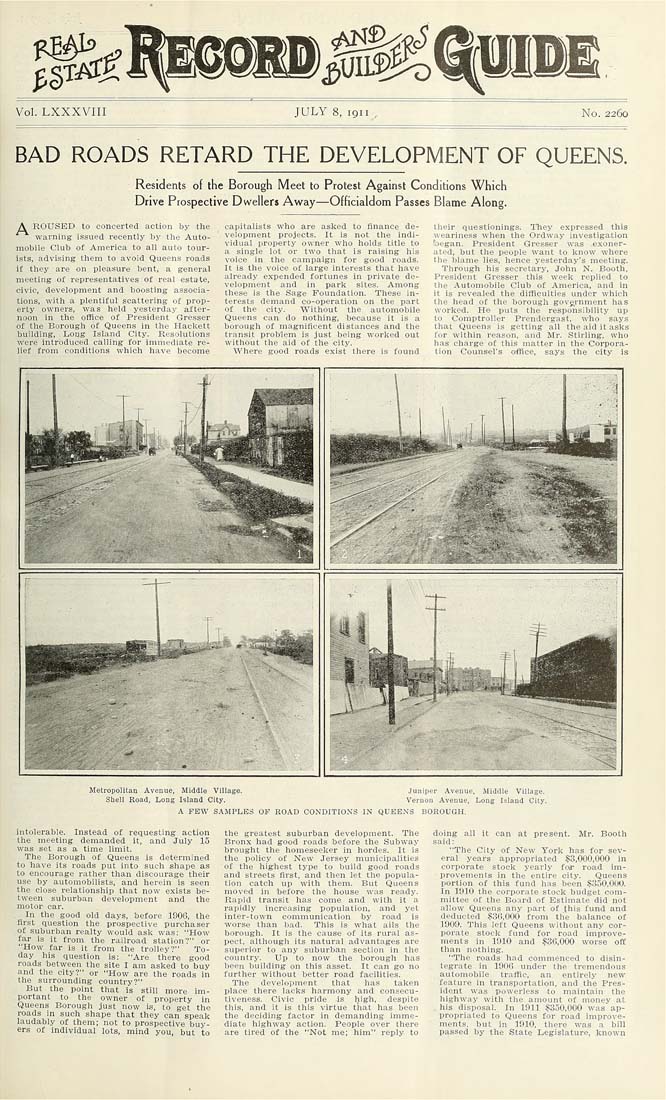Columbia University Libraries Digital Collections: The Real Estate Record
Use your browser's Print function to print these pages.
Real estate record and builders' guide: v. 88, no. 2260: July 8, 1911

Text version:
Please note: this text may be incomplete. For more information about this OCR, view About OCR text.
mm Vol. LXXXVIII JULY 8, igii , No. 2260 BAD ROADS RETARD THE DEVELOPMENT OF QUEENS. Residents of the Borough Meet to Protest Against Conditions Which Drive Prospective Dwellers Away—Officialdom Passes Blame Along. A ROUSED to concerted action by the warning issued recently by the Auto¬ mobile Club of America to all auto tour¬ ists, advising' them to avoid Queens roads if they are on pleasure bent, a general meeting oC representatives of real estate, civic, development and boosting associa¬ tions, with a plentiful scattering of prop¬ erty owners, was held yesterday after¬ noon in the office of President Grosser of the Borough of Queens in the Hackett building, Long Island City. Resolutions were introduced calling for immediate re¬ lief from conditions which have become capitalists who are asked to finance de¬ velopment projects. It is not the indi¬ vidual property owner who holds title to a single lot or two that is raising his voice in the campaign for good roads. IL is the voice of large interests that have already expended fortunes in private de¬ velopment and in park sites. Among these is the Sage Foundation. These in¬ terests demand co-operation on the part of the city. Without the automobile Queens can do nothing, because it \s a borough of magnificent distances and the transit problem is just being worked out without the aid of the city. Where good roads exist there is found their questionings, T'hey expressed this weariness when the Ord^vay investigation began. President Gresser was .exoner¬ ated, but the people Tvant to know where the blame lies, hence yesterday's meeting. Through his secretary, John N, Booth, President Gresser this week replied to the Automobile Club of America, and in it is revealed the difficulties under which the head of the borough government has worked. He puts the responsibility up to Comptroller Prendergast, who says that Queens is getting all the aid it asks for within reason, and Mr. Stirling, who has charge o£ this matter in the Corpora¬ tion Counsel's office, says the city is T. ^ ,■,>. Metropolitan Avenue, Middle Village. Juniper Avenue. Middle Village. Shell Road, Long Island City. Ventou Avenue, Long Island City. A FEW SAMPLES OF ROAD CONDITIONS IN QUEENS BOROUGH. intolerable. Instead of requesting action the meeting demanded it, and July 15 was set as a time limit. The Borough of Queens is determined to have its roads put into such shape as to encourage rather than discourage their use by automobilists, and herein is seen the close relationship that now exists be¬ tween suburban development and the motor car. In the good old days, before 10O6, the first question the prospective purchaser of suburban realty would ask was: "How far is it from the railroad station?" or "How far is it from the trolley?" To¬ day his question is: "Are there good roads between the site I am asked to buy and the city?" or "How are the roads in the surrounding country?" But the point that is still more im¬ portant to the owner of property in Queens Borough just now is, to get the roads m such shape that they can speak laudably of them; not to prospective buy¬ ers of individual lots, mind you, but to the greatest suburban development. Tlie Bronx had good roads before the Subway brought the homeseeker in hordes. It is the policy of New Jersey municipalities of the highest type to build good roads and streets first, and then let the popula¬ tion catch up with them. But Queens moved in before the house was ready. Rapid transit has come and with it a rapidly increasing population, and yet inter-town communication by road is worse than bad. This is what ails the borough. It is the cause of its rural as¬ pect, although its natural advantages are superior to any suburban section in the country. Up to now the borough has been building on this asset. It can go no further without better road facilities. The development that has taken place there lacks harmony and consecu- tiveness. Civic pride is high, despite this, and it is this virtue that has been the deciding factor in demanding imme¬ diate highway action. People over there are tired of the "Not me; him" reply to doing all it can at present. Mr. Booth said: "The City of New York has for sev¬ eral years appropriated $3,000,000 in corporate stock yearly for road im¬ provements in the entire city. Queens portion of this fund has been $350,000. In 1910 the corporate stock budget com¬ mittee of the Board of Estimate did not allow Queens any part of this fund and deducted .?3G,000 from the balance of 1900. This left Queens without any cor¬ porate stock fund for road improve¬ ments in 1010 and $36,000 worse off than nothing, "The roads had commenced to disin¬ tegrate in 190(i under the tremendous automobile traffic, an entirely new feature in transportation, and the Pres¬ ident was powerless to maintain the highway with the amount of money at his disposal. In 1911 $330,000 was ap¬ propriated to Queens for road improve¬ ments, but in 1910, there was a bill passed by the State Legislature, known